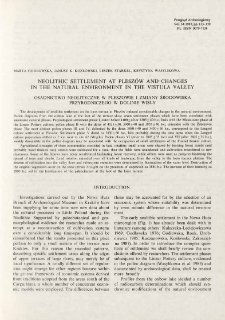
Obiekt
Tytuł: Neolithic settlement at Pleszów and changes in the natural environment in the Vistula Valley = Osadnictwo neolityczne w Pleszowie i zmiany środowiska przyrodniczego w dolinie Wisły
Twórca:
Godłowska, Marta ; Kozłowski, Janusz K. (1937– ) ; Starkel, Leszek (1931– ) ; Wasylikowa, Krystyna (1932– )
Data wydania/powstania:
Typ zasobu:
Inny tytuł:
Przegląd Archeologiczny T. 34 (1987)
Współtwórca:
Wydawca:
Polska Akademia Nauk. Instytut Historii Kultury Materialnej
Miejsce wydania:
Opis:
Typ obiektu:
Abstrakt:
The development of neolithic settlement on the loess terrace at Pleszów induced considerable changes in the natural environment. Pollen diagrams from the oxbow lake at the foot of the terrace show seven settlement phases which have been correlated with successive cultural phases. Palynological settlement phase I, dated before 4100 ±40 or 4305±40 b.c., links with the Music-note phase of the Linear Pottery culture; pollen phase II with the dates of 4035±50, 3960±40 and 3955±40 b.c., coincides with the Želiezovce phase. The most distinct pollen phases III and IV, delimited by the dates 3880±40 and 3430±60 b.c., correspond to the Lengyel culture settlement at Pleszów. Settlement phase V dated to 3430±60 B.C., falls probably during the time lapse when the Lengyel culture population shifted ca 2 km west to site 62 (Mogiła). Pollen phases VI (prior to 2805±35 b.c.) and VII (after 2805±35 b.c.),weakly discernible in the pollen diagram may be associated with the occupation of small settlements of the Funnel Beaker culture. Agricultural strategies of these communities consisted in land rotation: small areas were cleared by burning forest stands (and probably hazel thickets too), cereals were cultivated for a time, then the fields were abandoned and cultivation transferred to new clearances. Some of the fallows were never recultivated facilitating forest recovery, while others were used as pastures hindering the spread of trees and shrubs. Land rotation extended over all kinds of landscape, from the valley to the loess terrace plateau. The descent of cultivation into the valley floor and subsequent recession were determined by fluctuations of the water level. Destruction of the original vegetation cover on the loess terrace brought on the processes of slopewash ca 3880 b.c. The increase of their intensity ca 2800 b.c. led to the fossilization of the paleochannel at the foot of the loess terrace
Czasopismo/Seria/cykl:
Tom:
Strona pocz.:
Strona końc.:
Szczegółowy typ zasobu:
Format:
Identyfikator zasobu:
oai:rcin.org.pl:60332 ; 0079-7138
Źródło:
IAiE PAN, sygn. P III 149 ; IAiE PAN, sygn. P III 272 ; IAiE PAN, sygn. P III 353 ; kliknij tutaj, żeby przejść
Język:
Prawa:
Prawa zastrzeżone - dostęp nieograniczony
Zasady wykorzystania:
Digitalizacja:
Instytut Archeologii i Etnologii Polskiej Akademii Nauk
Lokalizacja oryginału:
Biblioteka Instytutu Archeologii i Etnologii PAN
Dofinansowane ze środków:
Ministra Nauki i Szkolnictwa Wyższego ; Działalność upowszechniająca naukę (DUN)
Dostęp:
Kolekcje, do których przypisany jest obiekt:
- Instytut Archeologii i Etnologii PAN > Publikacje Pracowników i Wydawnictwa IAE PAN
- Instytut Archeologii i Etnologii PAN > Publikacje Pracowników i Wydawnictwa IAE PAN > Czasopisma bieżące
- Instytut Archeologii i Etnologii PAN > Publikacje Pracowników i Wydawnictwa IAE PAN > Czasopisma bieżące > Przegląd Archeologiczny
Data ostatniej modyfikacji:
2 lut 2022
Data dodania obiektu:
1 gru 2016
Liczba pobrań / odtworzeń:
379
Wszystkie dostępne wersje tego obiektu:
https://www.rcin.org.pl/iae/publication/80019
Wyświetl opis w formacie RDF:
Wyświetl opis w formacie RDFa:
Wyświetl opis w formacie OAI-PMH:
| Nazwa wydania | Data |
|---|---|
| Godłowska, Marta, 1987, Neolithic settlement at Pleszów and changes in the natural environment in the Vistula Valley | 2 lut 2022 |
Obiekty Podobne
Kaczanowska, Małgorzata
Kulczycka-Leciejewiczowa, Anna (1934–2011)
Czerniak, Lech (1952– )
Dryja, Sławomir
Kulczycka-Leciejewiczowa, Anna (1934–2011)
Godłowska, Marta
Godłowska, Marta

 INSTYTUT ARCHEOLOGII I ETNOLOGII POLSKIEJ AKADEMII NAUK
INSTYTUT ARCHEOLOGII I ETNOLOGII POLSKIEJ AKADEMII NAUK
 INSTYTUT BADAŃ LITERACKICH POLSKIEJ AKADEMII NAUK
INSTYTUT BADAŃ LITERACKICH POLSKIEJ AKADEMII NAUK
 INSTYTUT BADAWCZY LEŚNICTWA
INSTYTUT BADAWCZY LEŚNICTWA
 INSTYTUT BIOLOGII DOŚWIADCZALNEJ IM. MARCELEGO NENCKIEGO POLSKIEJ AKADEMII NAUK
INSTYTUT BIOLOGII DOŚWIADCZALNEJ IM. MARCELEGO NENCKIEGO POLSKIEJ AKADEMII NAUK
 INSTYTUT BIOLOGII SSAKÓW POLSKIEJ AKADEMII NAUK
INSTYTUT BIOLOGII SSAKÓW POLSKIEJ AKADEMII NAUK
 INSTYTUT CHEMII FIZYCZNEJ PAN
INSTYTUT CHEMII FIZYCZNEJ PAN
 INSTYTUT CHEMII ORGANICZNEJ PAN
INSTYTUT CHEMII ORGANICZNEJ PAN
 INSTYTUT FILOZOFII I SOCJOLOGII PAN
INSTYTUT FILOZOFII I SOCJOLOGII PAN
 INSTYTUT GEOGRAFII I PRZESTRZENNEGO ZAGOSPODAROWANIA PAN
INSTYTUT GEOGRAFII I PRZESTRZENNEGO ZAGOSPODAROWANIA PAN
 INSTYTUT HISTORII im. TADEUSZA MANTEUFFLA POLSKIEJ AKADEMII NAUK
INSTYTUT HISTORII im. TADEUSZA MANTEUFFLA POLSKIEJ AKADEMII NAUK
 INSTYTUT JĘZYKA POLSKIEGO POLSKIEJ AKADEMII NAUK
INSTYTUT JĘZYKA POLSKIEGO POLSKIEJ AKADEMII NAUK
 INSTYTUT MATEMATYCZNY PAN
INSTYTUT MATEMATYCZNY PAN
 INSTYTUT MEDYCYNY DOŚWIADCZALNEJ I KLINICZNEJ IM.MIROSŁAWA MOSSAKOWSKIEGO POLSKIEJ AKADEMII NAUK
INSTYTUT MEDYCYNY DOŚWIADCZALNEJ I KLINICZNEJ IM.MIROSŁAWA MOSSAKOWSKIEGO POLSKIEJ AKADEMII NAUK
 INSTYTUT PODSTAWOWYCH PROBLEMÓW TECHNIKI PAN
INSTYTUT PODSTAWOWYCH PROBLEMÓW TECHNIKI PAN
 INSTYTUT SLAWISTYKI PAN
INSTYTUT SLAWISTYKI PAN
 SIEĆ BADAWCZA ŁUKASIEWICZ - INSTYTUT TECHNOLOGII MATERIAŁÓW ELEKTRONICZNYCH
SIEĆ BADAWCZA ŁUKASIEWICZ - INSTYTUT TECHNOLOGII MATERIAŁÓW ELEKTRONICZNYCH
 MUZEUM I INSTYTUT ZOOLOGII POLSKIEJ AKADEMII NAUK
MUZEUM I INSTYTUT ZOOLOGII POLSKIEJ AKADEMII NAUK
 INSTYTUT BADAŃ SYSTEMOWYCH PAN
INSTYTUT BADAŃ SYSTEMOWYCH PAN
 INSTYTUT BOTANIKI IM. WŁADYSŁAWA SZAFERA POLSKIEJ AKADEMII NAUK
INSTYTUT BOTANIKI IM. WŁADYSŁAWA SZAFERA POLSKIEJ AKADEMII NAUK
































